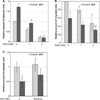Regulation of ionizing radiation-induced adhesion of breast cancer cells to fibronectin by alpha5beta1 integrin
- PMID: 24785587
- PMCID: PMC4101885
- DOI: 10.1667/RR13543.1
Regulation of ionizing radiation-induced adhesion of breast cancer cells to fibronectin by alpha5beta1 integrin
Abstract
Ionizing radiation (IR) is commonly used for cancer therapy, however, its potential influence on cancer metastatic potential remains controversial. In this study, we elucidated the role of integrins in regulation of IR-altered adhesion between breast cancer cells and extracellular matrix (ECM) proteins, which is a key step in the initial phase of metastasis. Our data suggest that the extent of effect that ionizing radiation had on cell adhesion depended on the genetic background of the breast cancer cells. Ionizing radiation was a better adhesion inducer for p53-mutated cells, such as MDA-MB-231 cells, than for p53 wild-type cells, such as MCF-7 cells. While IR-induced adhesions between MDA-MB-231 cells to fibronectin, laminin, collagen I and collagen IV, only blocking of the adhesion between α5β1 integrin and fibronectin using anti-α5β1 integrin antibody could completely inhibit the radiation-induced adhesion of the cells. A soluble Arg-Gly-Asp peptide, the binding motif for fibronectin binding integrins, could also reduce the adhesion of the cells to fibronectin with or without ionizing radiation exposure. The inhibition of the cell-fibronectin interaction also affected, but did not always correlate with, transwell migration of the cancer cells. In addition, our data showed that the total expression of α5 integrin and surface expression of α5β1 integrin were increased in the cells treated with ionizing radiation. The increased surface expression of α5β1 integrin, along with the adhesion between the cells and fibronectin, could be inhibited by both ataxia telangiectasia mutated (ATM) and Rad3-related (ATR) kinase inhibitors. These results suggested that ATM/ATR-mediated surface expression of α5β1 integrin might play a central role in regulation of ionizing radiation-altered adhesion.
Figures




Similar articles
-
Culture of human breast cancer cell line (MDA-MB-231) on fibronectin-coated surface induces pro-matrix metalloproteinase-9 expression and activity.Tumour Biol. 2011 Feb;32(1):129-38. doi: 10.1007/s13277-010-0106-9. Epub 2010 Sep 7. Tumour Biol. 2011. PMID: 20821288
-
Breast cancer cells in three-dimensional culture display an enhanced radioresponse after coordinate targeting of integrin alpha5beta1 and fibronectin.Cancer Res. 2010 Jul 1;70(13):5238-48. doi: 10.1158/0008-5472.CAN-09-2319. Epub 2010 Jun 1. Cancer Res. 2010. PMID: 20516121 Free PMC article.
-
Zinc inhibits magnesium-dependent migration of human breast cancer MDA-MB-231 cells on fibronectin.J Nutr Biochem. 2013 Jun;24(6):1034-40. doi: 10.1016/j.jnutbio.2012.07.013. Epub 2012 Sep 29. J Nutr Biochem. 2013. PMID: 23026493
-
Shedding New Light on The Role of ανβ3 and α5β1 Integrins in Rheumatoid Arthritis.Molecules. 2019 Apr 18;24(8):1537. doi: 10.3390/molecules24081537. Molecules. 2019. PMID: 31003546 Free PMC article. Review.
-
Targeting integrin α5β1 in urological tumors: opportunities and challenges.Front Oncol. 2023 Jul 6;13:1165073. doi: 10.3389/fonc.2023.1165073. eCollection 2023. Front Oncol. 2023. PMID: 37483505 Free PMC article. Review.
Cited by
-
Interest of integrins targeting in glioblastoma according to tumor heterogeneity and cancer stem cell paradigm: an update.Oncotarget. 2017 Aug 21;8(49):86947-86968. doi: 10.18632/oncotarget.20372. eCollection 2017 Oct 17. Oncotarget. 2017. PMID: 29156849 Free PMC article. Review.
-
Cytoskeleton Response to Ionizing Radiation: A Brief Review on Adhesion and Migration Effects.Biomedicines. 2021 Aug 28;9(9):1102. doi: 10.3390/biomedicines9091102. Biomedicines. 2021. PMID: 34572287 Free PMC article. Review.
-
Radiation therapy-induced metastasis: radiobiology and clinical implications.Clin Exp Metastasis. 2018 Apr;35(4):223-236. doi: 10.1007/s10585-017-9867-5. Epub 2017 Nov 20. Clin Exp Metastasis. 2018. PMID: 29159430 Review.
-
Starvation after Cobalt-60 γ-Ray Radiation Enhances Metastasis in U251 Glioma Cells by Regulating the Transcription Factor SP1.Int J Mol Sci. 2016 Apr 5;17(4):386. doi: 10.3390/ijms17040386. Int J Mol Sci. 2016. PMID: 27058528 Free PMC article.
-
Triple negative aggressive phenotype controlled by miR-135b and miR-365: new theranostics candidates.Sci Rep. 2021 Mar 22;11(1):6553. doi: 10.1038/s41598-021-85746-w. Sci Rep. 2021. PMID: 33753785 Free PMC article.
References
-
- Hehlgans S, Haase M, Cordes N. Signalling via integrins: implications for cell survival and anticancer strategies. Biochim Biophys Acta. 2007;1775:163–180. - PubMed
-
- Caswell PT, Spence HJ, Parsons M, White DP, Clark K, Cheng KW, et al. Rab25 associates with alpha5beta1 integrin to promote invasive migration in 3D microenvironments. Dev Cell. 2007;13:496–510. - PubMed
-
- Guo W, Giancotti FG. Integrin signalling during tumour progression. Nat Rev Mol Cell Biol. 2004;5:816–826. - PubMed
Publication types
MeSH terms
Substances
Grants and funding
LinkOut - more resources
Full Text Sources
Other Literature Sources
Medical
Research Materials
Miscellaneous

